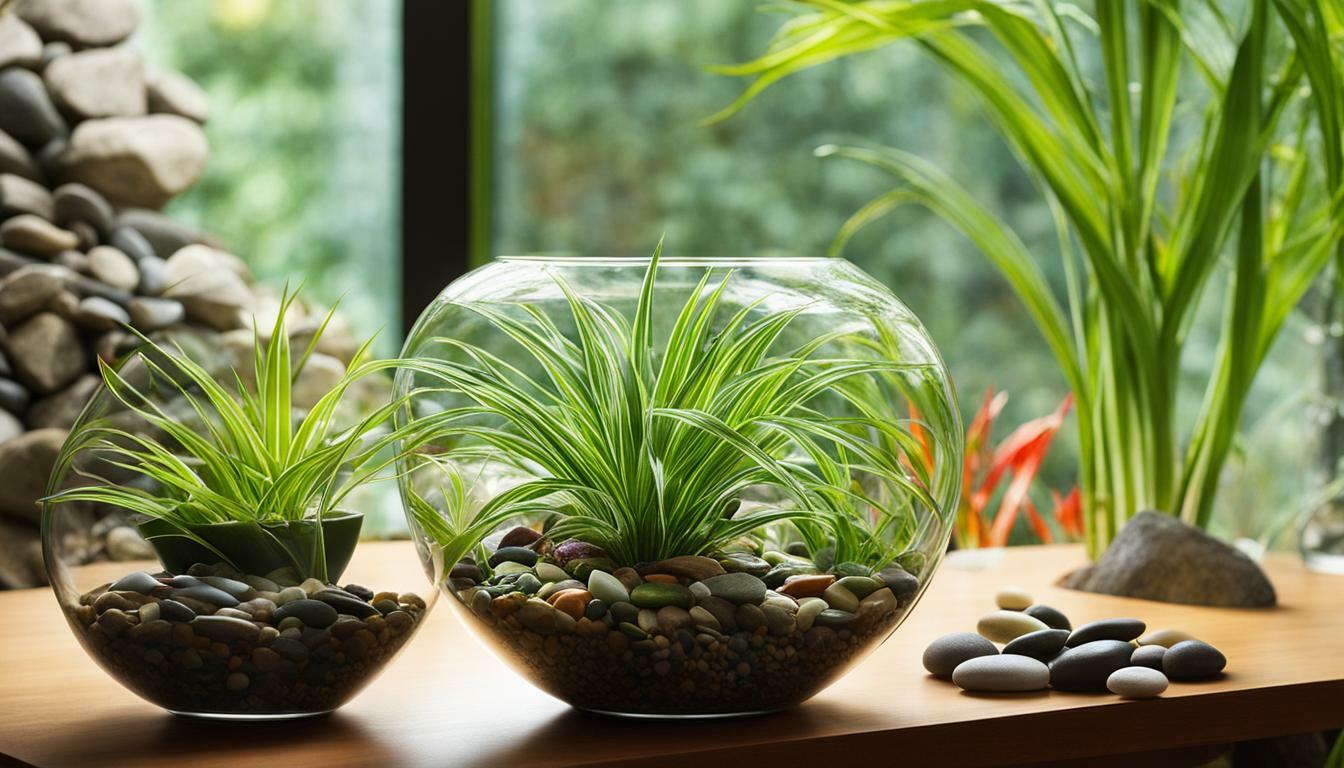Spider plants, also known as Chlorophytum comosum, are popular indoor plants that are perfect for terrarium gardening. These decorative plants are not only aesthetically pleasing but also relatively easy to grow and care for, making them an ideal choice for both beginner and experienced plant enthusiasts.
- Spider plants are versatile and can thrive in both indoor and outdoor environments.
- Repotting spider plants in a porous container with good drainage is crucial for their health and growth.
- Spider plants prefer bright to moderate indirect sunlight and should be watered when the top two inches of soil are dried out.
- Propagating spider plants by planting the baby spiderlings is a simple and effective way to expand your collection or share with others.
- Spider plants are known for their air-purifying abilities and can contribute to a healthier living environment.
These low-maintenance terrarium plants are not only visually appealing but also offer various benefits, making them an excellent choice for indoor decoration. Whether you’re a plant enthusiast looking to expand your collection or someone new to gardening, spider plants are sure to bring a touch of green to your space without demanding too much time and effort.
Choosing the Right Terrarium for Spider Plants
When choosing a terrarium for your spider plants, it’s crucial to find one that provides ample space and proper ventilation for optimal growth. Spider plants have long, arching leaves that can grow up to two feet in length, so a terrarium with enough height and width is essential.
Opt for a terrarium made of glass or clear plastic, as these materials allow for maximum light penetration. This is important because spider plants thrive in bright to moderate indirect sunlight. Additionally, a transparent terrarium will allow you to easily monitor the moisture levels in the soil and the overall health of your plant.
Consider the size of your spider plant when selecting a terrarium. It’s recommended to choose a container that is at least twice the size of the plant’s root ball, as spider plants grow quickly and need room to spread out. A terrarium that is too small can limit root growth and ultimately stunt the plant’s development.
| Terrarium Material | Advantages |
|---|---|
| Glass | Allows maximum light penetration, easy to monitor plant health |
| Clear Plastic | Lightweight, affordable, and provides good visibility |
Remember to provide adequate drainage in your terrarium. Spider plants do not like to sit in waterlogged soil, as this can lead to root rot. Ensure that your terrarium has drainage holes at the bottom and place a layer of rocks or pebbles to create a reservoir for excess water to drain into.
By selecting the right terrarium for your spider plants, you can create a suitable environment for them to thrive and add a touch of greenery to your space.
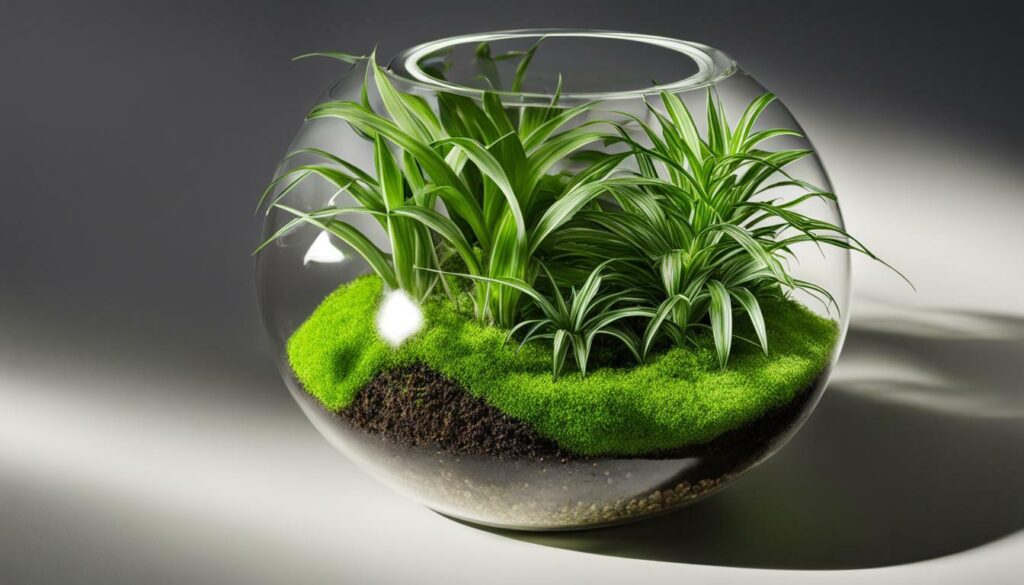
“When it comes to choosing a terrarium for your spider plants, prioritize functionality over aesthetics. Remember, the terrarium needs to provide the optimal conditions for your plants to grow and flourish.”
Repotting Spider Plants in Terrariums
Repotting spider plants in terrariums is essential for their health and growth, allowing them to thrive in a more suitable environment. Spider plants, also known as Chlorophytum comosum, are popular indoor plants that are renowned for their air-purifying abilities and ability to adapt to different conditions. However, as they grow, they may outgrow their current container and require repotting to provide them with more space to spread their roots.
When repotting spider plants in terrariums, it’s important to choose a porous container with good drainage. This will help prevent waterlogging and promote proper air circulation to the plant’s roots. The terrarium should have drainage holes at the bottom to ensure excess water can escape, preventing root rot. It is also recommended to use a well-draining soil mixture, such as a combination of regular potting soil and perlite or vermiculite.
| Benefits of Repotting Spider Plants in Terrariums: |
|---|
| Provides more space for root growth |
| Prevents root rot and waterlogging |
| Allows for better air circulation |
| Promotes healthy and vigorous growth |
To repot a spider plant, carefully remove it from its current container, gently separate the roots, and place it in the new terrarium. Make sure the plant is centered and the roots are spread out evenly. Fill the remaining space with the soil mixture, leaving a small gap between the soil and the rim of the terrarium to allow for watering.
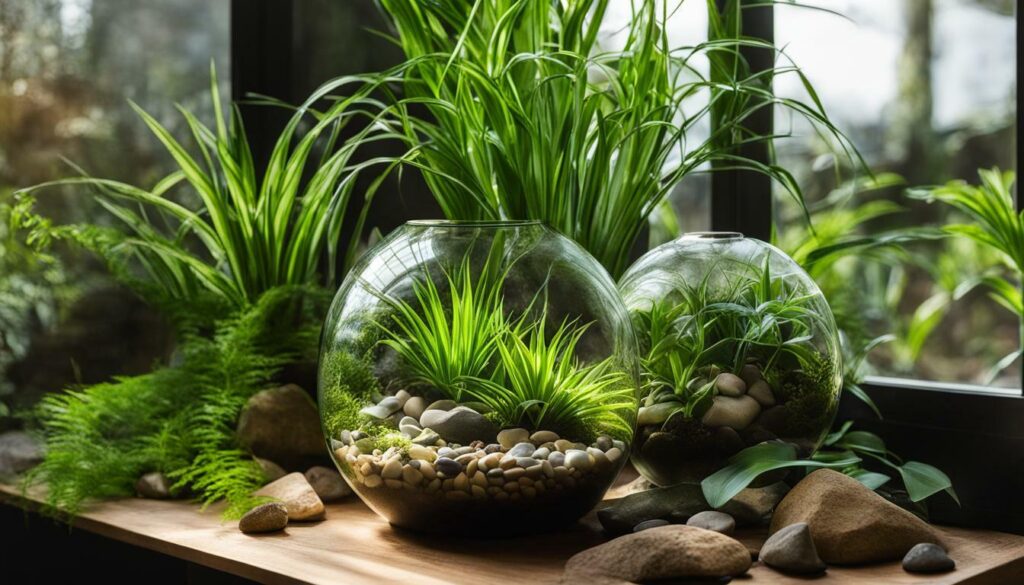
After repotting, water the spider plant thoroughly, allowing the water to soak through the soil and drain out of the bottom. Avoid overwatering as this can lead to root rot. Monitor the moisture levels and water the plant when the top two inches of soil are dry to the touch. Spider plants appreciate a slightly humid environment, so misting them with distilled water that has been sitting for 24 hours can also help maintain the desired moisture levels.
By providing the right conditions and repotting spider plants in terrariums, plant enthusiasts can ensure their spider plants thrive and continue to enhance their indoor space with their lush green foliage.
Providing the Right Lighting for Spider Plants
Spider plants thrive in bright to moderate indirect sunlight, making them an ideal choice for terrariums placed in well-lit areas of your home or office. These plants have a natural ability to adapt to various light conditions, but they prefer bright, indirect light to maintain their vibrant green leaves and promote healthy growth.
When positioning your terrarium, consider placing it near a window that receives filtered or dappled sunlight throughout the day. Avoid direct sunlight, as it can scorch the leaves and cause damage to the plant. Positioning the terrarium on a table or shelf, closer to eye level, will not only provide the right amount of light but also create an attractive display.
It’s important to note that terrariums can create a microenvironment that may affect the light conditions. The glass walls can intensify the light, so you may need to adjust the positioning of your terrarium based on the specific lighting needs of your spider plants. Regularly monitor the plants’ response to the light and make adjustments as necessary for optimal growth.
| Lighting Conditions | Suitability for Spider Plants |
|---|---|
| Bright Indirect Light | Ideal for promoting healthy growth and vibrant foliage |
| Moderate Indirect Light | Acceptable for maintaining spider plants, but may result in slower growth |
| Low Light | Spider plants can tolerate low-light conditions but may become leggy and lose their vibrant color |
| Direct Sunlight | Avoid direct sunlight as it can burn the leaves and cause damage |
Remember to rotate your terrarium periodically to ensure even light exposure on all sides of the plants. This will prevent the plants from leaning towards the light source and maintain their balanced growth.
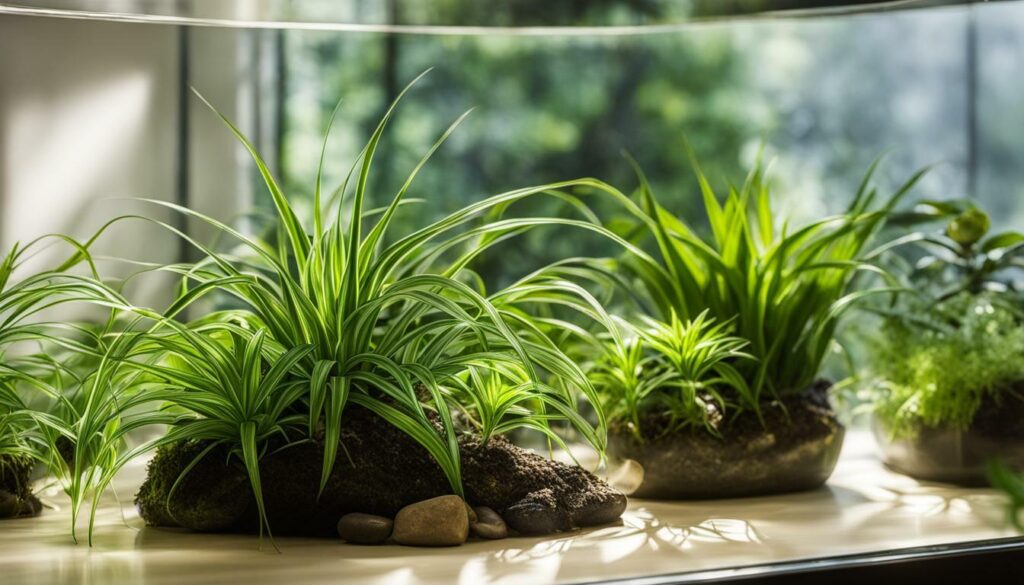
In conclusion, providing the right lighting conditions is essential for the health and well-being of your spider plants in terrariums. With their adaptability to various light conditions, these plants can thrive in bright to moderate indirect light. By carefully positioning your terrarium and monitoring the light levels, you can create an ideal environment for your spider plants to flourish and add a touch of natural beauty to your home or office.
Watering Spider Plants in Terrariums
Proper watering is crucial for the health and vitality of your spider plants in terrariums, as overwatering or underwatering can negatively impact their growth. Spider plants have moderate watering needs, and finding the right balance is key to their success. Here are some guidelines to help you keep your spider plants hydrated:
- Check the moisture level: Before watering, check the top two inches of soil in the terrarium. If it feels dry, it’s time to water. If it is still moist, wait a few more days before watering.
- Opt for distilled water: Spider plants are sensitive to chemicals found in tap water, so it’s best to use distilled water. If distilled water is not available, you can leave tap water out for 24 hours to allow chlorine and other chemicals to evaporate.
- Avoid overwatering: Spider plants prefer being slightly underwatered rather than overwatered. Too much water can lead to root rot and other issues. Make sure the soil is damp but not soggy. If there is excess water in the tray beneath the terrarium, remove it to prevent root damage.
By following these watering guidelines, you can ensure the optimal health and growth of your spider plants in terrariums. Remember to observe your plants regularly and adjust watering frequency as needed based on their individual needs.
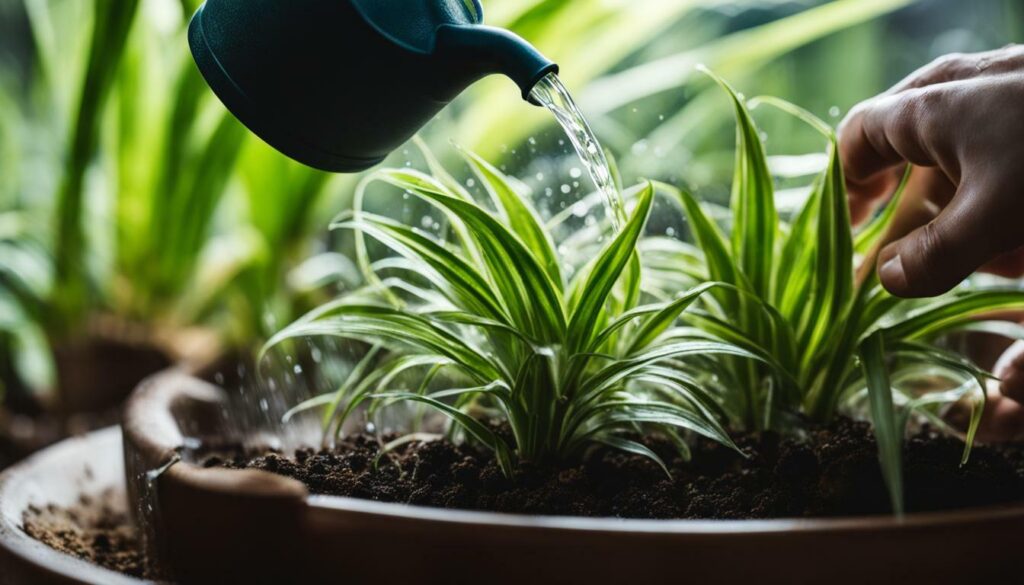
Spider plants in terrariums typically require watering every 1-2 weeks, depending on the humidity levels and temperature in your home. You can use the following schedule as a starting point and adjust it based on the specific conditions of your terrarium:
| Humidity Level | Temperature | Watering Frequency |
|---|---|---|
| Low | Cool | Every 2 weeks |
| Medium | Moderate | Every 1-2 weeks |
| High | Warm | Every 1 week |
Remember, these are general guidelines and may need to be adjusted based on the specific conditions in your home. Always monitor your plants closely and make watering decisions accordingly.
Propagating Spider Plants in Terrariums
Spider plants are incredibly easy to propagate in terrariums, allowing you to create new plants from the spiderlings they produce. The process of propagating spider plants is simple and rewarding, making it a popular choice for plant enthusiasts. To propagate spider plants in a terrarium, follow these steps:
- Identify the spiderlings: Spider plants produce small plantlets known as spiderlings that grow from long stems. These spiderlings can be easily identified by their miniature versions of the parent plant’s leaves.
- Prepare a new container: Choose a small, well-draining container for planting the spiderlings. Fill the container with a suitable potting mix, such as a mix of peat moss and perlite.
- Separate the spiderlings: Gently separate the spiderlings from the parent plant, ensuring that each spiderling has its root system intact. Take care not to damage the roots during this process.
- Plant the spiderlings: Place each spiderling into the prepared container, burying the roots in the potting mix. Ensure that the spiderlings are evenly spaced, allowing room for growth.
- Provide proper care: After planting the spiderlings, water them lightly to settle the soil. Place the container in a bright, indirect sunlight location and water the spiderlings regularly, keeping the soil slightly moist but not soggy.
By following these propagation steps, you can expand your spider plant collection and enjoy the beauty of these versatile plants in your terrarium. Spider plants are known for their ability to purify the air, making them a popular choice for indoor gardening.
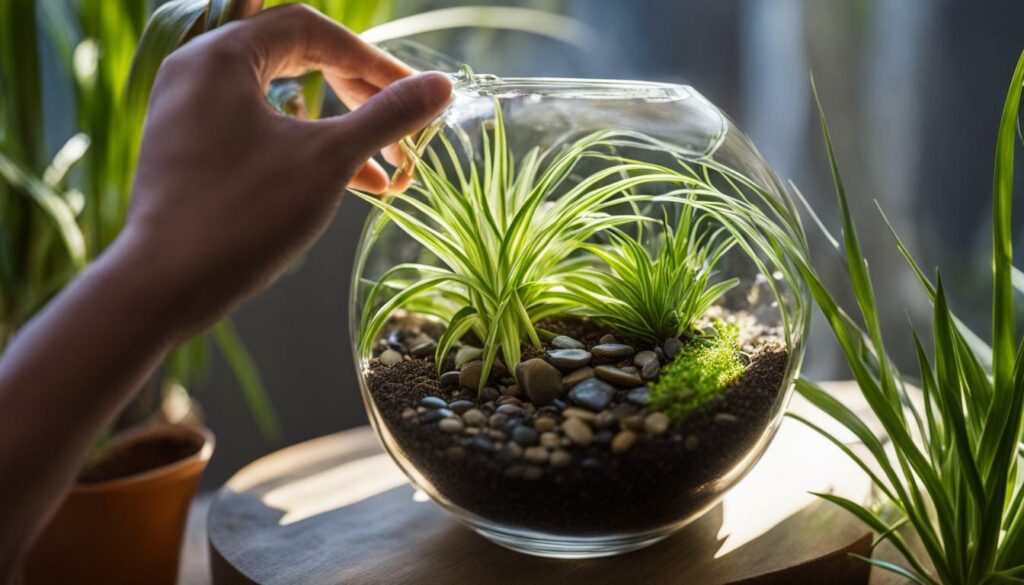
Overall, spider plants are a great addition to any terrarium, providing a touch of greenery and natural beauty. Their ease of propagation, low-maintenance nature, and air-purifying abilities make them a favorite among plant enthusiasts. So, why not give it a try and start propagating spider plants in your terrarium today?
Air Purification Abilities of Spider Plants
Spider plants are renowned for their air-purifying abilities, making them a popular choice for those seeking to improve the air quality in their homes or offices. These plants have the natural ability to remove harmful toxins from the air, including formaldehyde, benzene, and carbon monoxide. They do this by absorbing these toxins through their leaves and roots, converting them into harmless substances, and releasing oxygen back into the environment.
Research has shown that spider plants can effectively reduce indoor air pollutants, making them an excellent choice for anyone looking to create a healthier living space. In addition to their air-purifying properties, spider plants are also easy to care for, making them an ideal choice for beginners or those with busy lifestyles. They thrive in a variety of conditions and can tolerate low-light environments, making them suitable for any room in the house.
To maximize the air purification abilities of spider plants, it is recommended to have at least one plant per 100 square feet of living space. This ensures that there are enough plants to effectively filter the air in the room. Additionally, regularly dusting the leaves of the spider plants helps to improve their efficiency by preventing dust particles from clogging the pores of the leaves.
| Benefits of Spider Plants | How to Care for Spider Plants |
|---|---|
| – Removes harmful toxins from the air | – Place in bright to moderate indirect sunlight |
| – Releases oxygen and improves air quality | – Water when top two inches of soil are dried out |
| – Thrives in a variety of indoor conditions | – Mist with distilled water |
| – Low-maintenance and easy to care for | – Repot in a porous container with good drainage |
Overall, spider plants not only add a touch of greenery to your indoor space but also provide numerous health benefits. Their air-purifying abilities, combined with their minimal care requirements, make them an excellent choice for those looking to create a healthy and vibrant home or office environment.
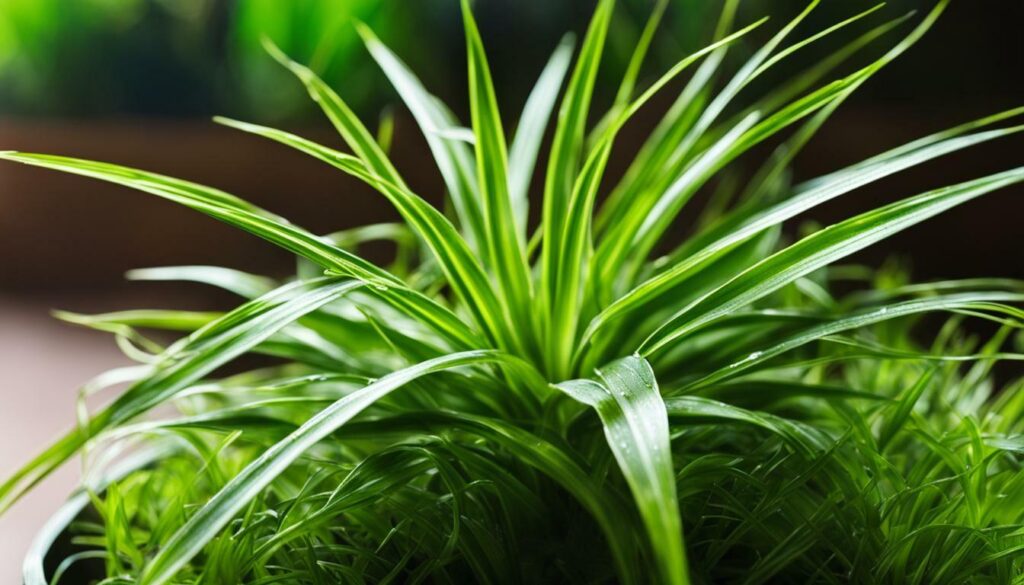
Spider Plants: Minimal Care Requirements
If you’re looking for a low-maintenance house plant, spider plants are the perfect choice with their minimal care requirements. These popular indoor plants are not only aesthetically pleasing but also easy to grow and maintain. Whether you’re a seasoned plant enthusiast or just starting your green thumb journey, spider plants are a versatile addition to any home or office.
To ensure the health and vitality of your spider plants, one important consideration is repotting. These plants thrive when given ample room for their roots to grow. Choose a porous container with good drainage to prevent waterlogged soil, which can lead to root rot. Repotting every couple of years will allow your spider plants to continue flourishing.
Spider plants prefer bright to moderate indirect sunlight. Placing them near a window with filtered light or in a well-lit room is ideal. Direct sunlight can scorch their leaves, while low light conditions may affect their growth. Aim for a balance and observe the plant’s response, adjusting their location as needed.
Watering spider plants is relatively simple. Check the moisture level of the soil by inserting your finger about an inch or two into the soil. Water the plant when the top two inches of soil are dried out, but avoid letting it completely dry through. Overwatering can lead to yellow or brown leaves. It’s also recommended to mist your spider plants with distilled water that has been sitting for 24 hours to prevent the build-up of chlorine and other chemicals.
In addition to their low-maintenance care requirements, spider plants are known for their air-purifying abilities. While the extent of their air purification is still debated, they have been shown to remove certain toxins from the air. Adding a spider plant to your indoor space can contribute to a healthier living environment.
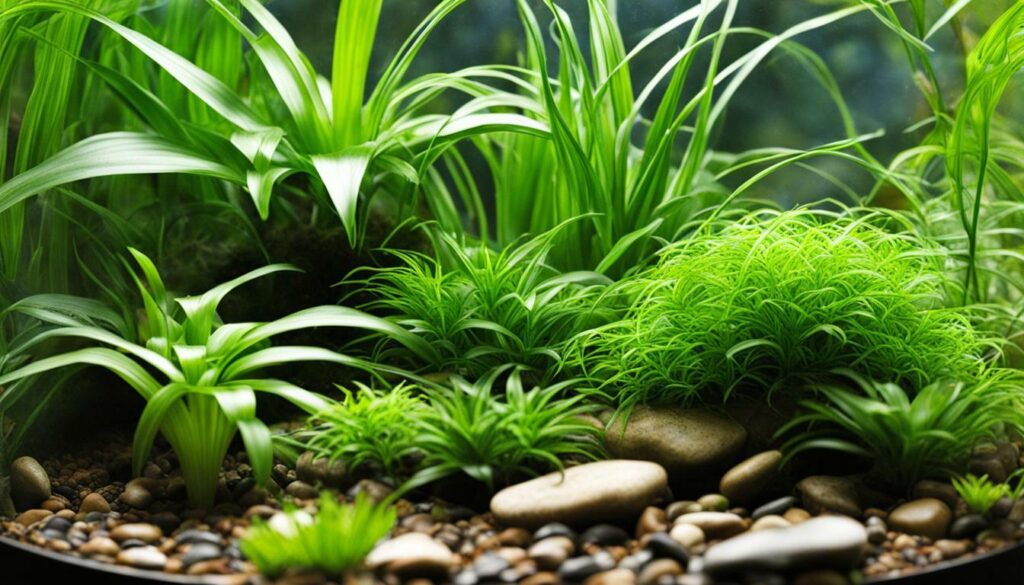
- Spider plants are low-maintenance house plants.
- Repotting in a porous container with good drainage promotes healthy growth.
- Spider plants prefer bright to moderate indirect sunlight.
- Water when the top two inches of soil are dried out, but avoid overwatering.
- Mist with distilled water to prevent chemical build-up and maintain humidity.
- Spider plants have air-purifying abilities and contribute to a healthier indoor environment.
| Care Requirements | Spider Plants |
|---|---|
| Lighting | Bright to moderate indirect sunlight |
| Watering | When top two inches of soil are dried out |
| Repotting | Every couple of years in a porous container |
| Air Purification | Contributes to a healthier indoor environment |
Tips for a Healthy Terrarium Environment
Creating a healthy environment within your terrarium is essential for the overall well-being of your spider plants. These indoor plants thrive in controlled environments, and with proper care, they can flourish and beautify your home or office space. To ensure the optimal growth and longevity of your terrarium plants, consider the following tips:
- Choose the right terrarium: Select a terrarium that provides adequate space and ventilation for your spider plants. A well-ventilated terrarium will prevent excessive moisture buildup and allow for proper air circulation.
- Control humidity levels: Spider plants thrive in environments with moderate humidity. Aim for humidity levels between 40% and 60% to create an ideal climate for your terrarium plants. You can use a hygrometer to monitor humidity levels and adjust them accordingly.
- Ensure proper lighting: Spider plants require bright to moderate indirect sunlight to thrive. Place your terrarium in a location that receives sufficient natural light, but avoid direct sunlight, as it can scorch the leaves. If natural light is limited, you can supplement with artificial grow lights.
- Water with care: Overwatering is a common mistake that can harm spider plants. Water your terrarium plants only when the top two inches of soil are dry, but not entirely dried through. Avoid soggy soil, as it can lead to root rot. Use distilled water or tap water that has been sitting for at least 24 hours to dissipate chlorine and other harmful chemicals.
“A well-maintained terrarium environment provides the necessary conditions for spider plants to thrive. By paying attention to factors like terrarium selection, humidity control, lighting, and watering, you can ensure your spider plants stay healthy and vibrant.”
By following these tips, you can create an optimal environment for your spider plants in a terrarium. Keep in mind that different species of spider plants may have slightly different care requirements, so it’s always beneficial to research specific species and adjust your care routine accordingly. With a little attention and care, your terrarium plants will reward you with their beautiful foliage and air-purifying qualities, adding a touch of green to your home or office space.
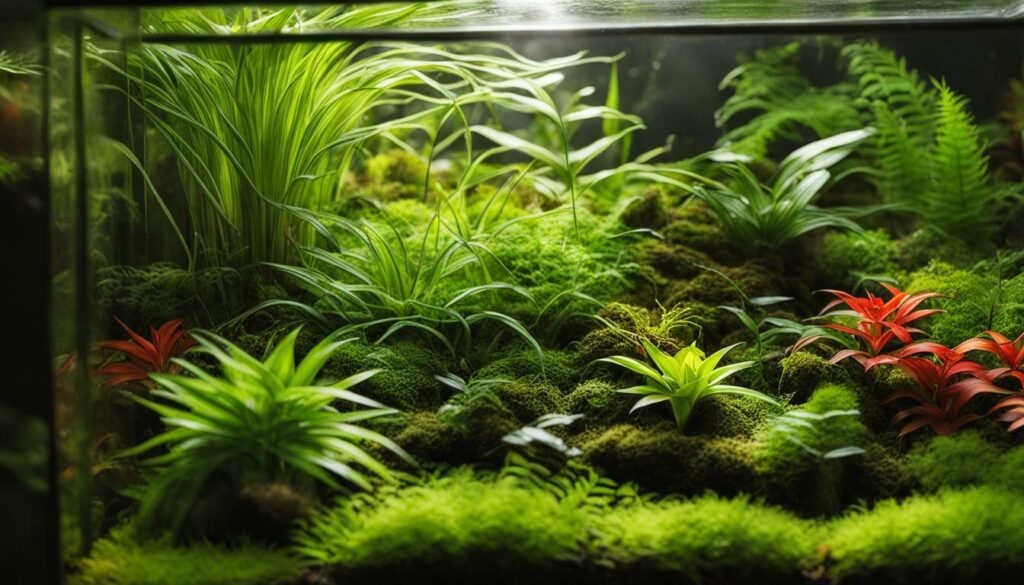
While spider plants are relatively hardy, they may face certain issues that can be easily resolved with proper care and attention. Here are some common problems you may encounter when caring for spider plants in terrariums, along with simple solutions:
Yellowing Leaves
If you notice that the leaves of your spider plant are turning yellow, it could be a sign of overwatering. Spider plants prefer slightly dry conditions, so make sure you are allowing the top two inches of soil to dry out before watering again. Additionally, ensure that your terrarium has adequate drainage to prevent water from pooling at the bottom. If the yellowing leaves persist, you may need to repot the plant in a fresh, well-draining potting mix.
Brown Tips
Brown tips on spider plant leaves can be caused by various factors, including low humidity or exposure to excessive sunlight. To prevent this issue, consider misting the leaves with distilled water or placing a humidifier near the terrarium to increase the humidity levels. Additionally, make sure your spider plant is not receiving direct sunlight, as this can scorch the leaves. If the brown tips continue to appear, you may need to adjust the lighting conditions or the location of your terrarium.
Pest Infestations
Spider plants are generally resistant to pests, but they can occasionally attract spider mites or mealybugs. To combat these pests, regularly inspect your plant for any signs of infestation, such as webbing or tiny insects. If you notice any, gently wipe the leaves with a cloth dipped in a mild soapy water solution. You can also introduce natural predators like ladybugs to control the infestation. Keeping your terrarium clean and free from debris will also help prevent pests from taking hold.
By addressing these common issues promptly, you can ensure that your spider plants thrive in your terrarium. Remember to monitor their watering, lighting, and humidity needs, and provide them with the care and attention they require. With a little troubleshooting and maintenance, your spider plants will continue to be a beautiful and vibrant addition to your indoor garden.
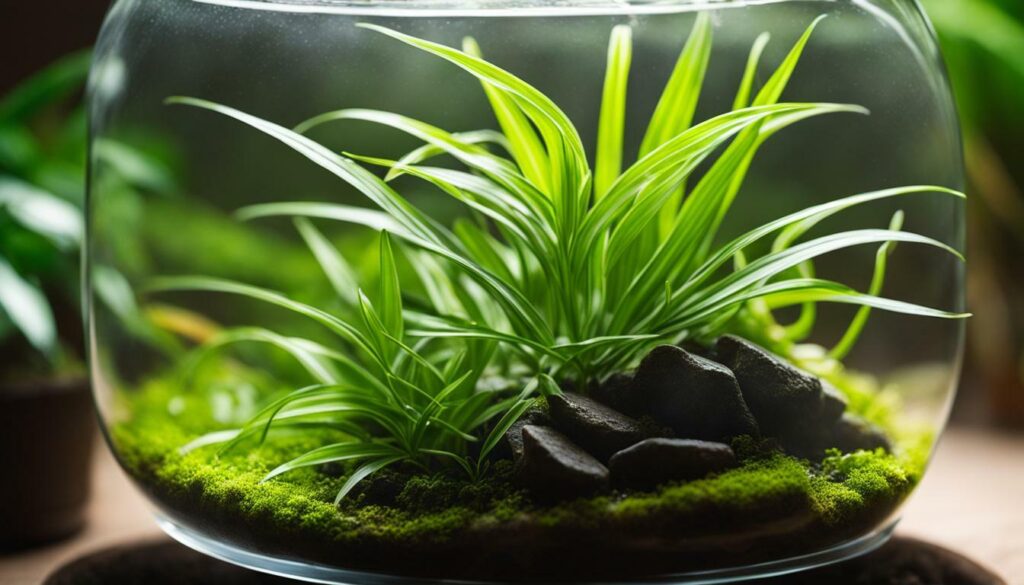
| Common Spider Plant Issues | Solutions |
|---|---|
| Yellowing Leaves | Allow soil to dry out before watering; ensure proper drainage |
| Brown Tips | Mist leaves with distilled water; adjust lighting and humidity levels |
| Pest Infestations | Inspect plant regularly; wipe leaves with mild soapy water solution; introduce natural predators |
Conclusion
Spider plants are versatile and visually striking terrarium plants that can bring a touch of natural beauty to any indoor space. These decorative plants are not only aesthetically pleasing but also easy to grow and care for, making them a popular choice for both beginner and experienced plant enthusiasts.
To ensure the health and vitality of spider plants, it is important to repot them in a porous container with good drainage. This allows for proper airflow and prevents waterlogging, which can lead to root rot. Spider plants prefer bright to moderate indirect sunlight, making them ideal for well-lit indoor areas that receive filtered light.
When it comes to watering, spider plants are relatively low-maintenance. They should be watered when the top two inches of soil are dried out but not entirely dried through. It is important to avoid overwatering, as this can cause the leaves to turn yellow or brown. Additionally, misting the leaves with distilled water that has been sitting for 24 hours can help create a humid environment that spider plants thrive in.
Spider plants are also known for their air-purifying abilities, although the extent of their air purification is still debated. These plants have been found to help remove toxins such as formaldehyde and carbon monoxide from the air, making them a great choice for those looking to improve indoor air quality. With their minimal care requirements and ability to enhance green home decor, spider plants are a wonderful addition to any home or office.
Can Spider Plants be Used as Ground Cover in a Terrarium Ecosystem?
Yes, spider plants can be used as optimal ground cover plants in a terrarium ecosystem. Their sprawling and trailing nature make them excellent for filling in empty spaces, adding texture, and providing a lush, green backdrop for smaller plants. They are also easy to care for, making them a popular choice for terrarium gardens.
FAQ
How do I repot a spider plant in a terrarium?
To repot a spider plant in a terrarium, carefully remove the plant from its current container and gently separate the roots. Place the plant in a new, porous terrarium container with good drainage, ensuring that the roots are covered with soil. Avoid over-packing the soil to allow for proper airflow.
How much light do spider plants need in a terrarium?
Spider plants prefer bright to moderate indirect sunlight in a terrarium. Place them near a window or in an area with filtered light. Avoid direct sunlight, as it can scorch the leaves. If needed, use artificial light sources to supplement natural light.
How often should I water a spider plant in a terrarium?
Water a spider plant in a terrarium when the top two inches of soil are dried out but not entirely dried through. It’s important to avoid overwatering, as this can lead to root rot. Check the soil moisture regularly and adjust your watering frequency accordingly.
How can I propagate spider plants in a terrarium?
Spider plants can easily be propagated in a terrarium by planting the baby spiderlings in their own container. Gently remove the spiderlings from the parent plant once they have developed roots, and plant them in a small, well-draining terrarium container using a suitable potting mix. Keep the soil lightly moist until the spiderlings establish themselves.
Do spider plants effectively purify the air in a terrarium?
Spider plants are known for their air-purifying abilities, although the extent of their air purification is still debated. While they can help remove some common indoor pollutants, it’s important to note that the overall air quality in a terrarium will depend on various factors, including the size of the enclosure and the presence of other plants.

